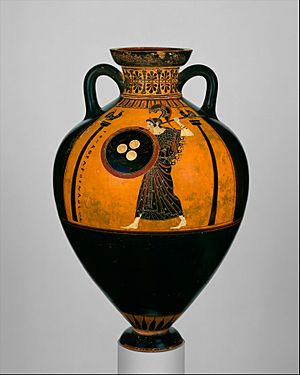Euphiletos Painter Panathenaic prize amphora facts for kids

The Euphiletos Painter Panathenaic Amphora is a special type of ancient Greek pot called an amphora. It's made of terracotta (baked clay) and decorated with a style called black-figure, where figures are black against a reddish background. This amphora was created around 530 BC, during a time known as the Archaic Period in ancient Greece. It shows a running race and was painted by an artist known as the Euphiletos Painter. This pot was given as a prize at the Panathenaic Games in Athens, a big sports festival similar to the Olympics. Today, you can see it at the Metropolitan Museum of Art in New York.
Contents
What Does the Amphora Look Like?
This amphora was crafted by the Euphiletos Painter around 530 BC. It was found in a region of Greece called Attica. The pot is made from terracotta and stands about 62.2 centimeters (24.5 inches) tall.
Pictures on the Pot
On one side of the amphora, you can see a picture of a foot race. This type of race was called a stadion in ancient Greece. On the other side, there is a picture of Athena Promachos. Athena was the goddess of wisdom and war, and "Promachos" means "front-fighter."
Athena's Image
Many Panathenaic prize amphorae showed Athena in this fighting pose. She holds a spear in one hand and a shield in the other. Athena stands between two tall pillars, and on top of each pillar sits a rooster. Next to the left pillar, there is writing in ancient Greek.
Black-Figure Style
This amphora is painted in the black-figure style, which was very common for these prize pots. In this style, the figures are painted in black silhouette (like shadows) on the reddish clay. Details like muscles or clothing folds are then scratched into the black paint, showing the reddish clay underneath. The runners in the race are shown nude, with beards and strong muscles. Running nude was a common practice in these ancient games. Each of the five runners has their left leg stretched forward in a long stride. The pot itself is mostly black, with the reddish-brown areas showing off the black figures. Around the neck of the pot, there is a painted black chain design. The black handles of the amphora connect the neck to the main body of the pot.
Why Was This Amphora Important?
These Panathenaic prize amphorae were more than just pots; they were symbols of high status and achievement. They celebrated the amazing athletes and the cultural importance of winning at the Panathenaic Games.
The Panathenaic Games
The games included many different events. There were foot races like the stadion, wrestling and boxing combined (called pankration), music contests, and horse races.
A Prize of Sacred Oil
If an athlete won an event, they would receive this amphora filled with olive oil. This oil came from Athena's sacred olive groves, which were very special to the Greeks. Olive oil was a valuable product and a sign of wealth and respect.
History of Amphorae
Amphorae were mainly used for storing things like wine or oil. Over time, their use changed. During the Late Geometric Period, large amphorae were sometimes used as markers for graves. Their size and decorations could show how important the person buried there was. Later, smaller pots called aryballos were used for valuable oils like perfumes. This history of pots, from simple storage to symbols of social status, led to the creation of the Panathenaic prize amphorae. These pots became important symbols of victory, decorated beautifully and holding sacred oil. The Euphiletos Painter created many of these prize amphorae, each celebrating different events at the Panathenaic Games.
See also
 In Spanish: Ánfora panatenaica del Pintor de Eufileto para niños
In Spanish: Ánfora panatenaica del Pintor de Eufileto para niños

